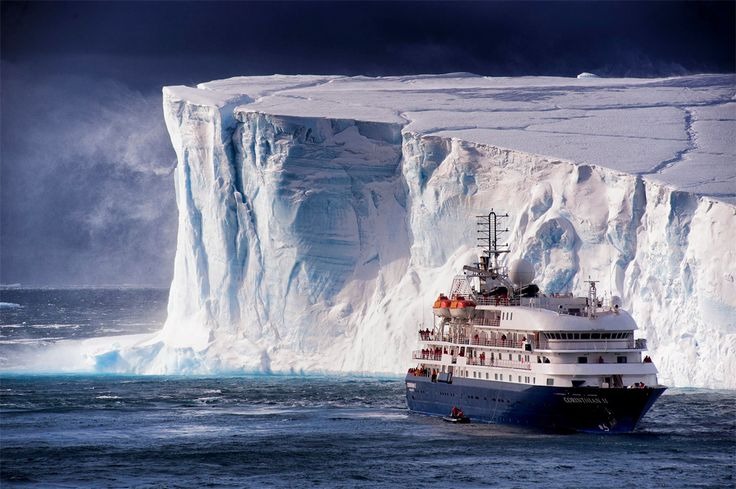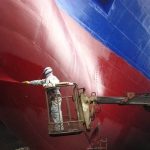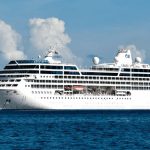The Titanic disaster in 1912 remains one of the most infamous shipwrecks in history. But what if a modern ship were to hit an iceberg today? With advancements in shipbuilding, navigation, and safety technologies, the chances of a catastrophic iceberg collision have been drastically reduced. However, icebergs still pose a risk to ships navigating polar regions. In this article, we explore how modern ships handle iceberg collisions, the safety protocols in place, and what happens if disaster strikes.
1. Why Are Icebergs Still a Threat Today?
Icebergs are massive chunks of ice that break off from glaciers and float in the ocean. They can weigh millions of tons and extend far below the water’s surface. Despite satellite tracking and improved navigation systems, ships still face potential risks from icebergs in areas like the North Atlantic, the Arctic, and around Antarctica.
Key Risks of Icebergs:
🧊 Hidden Mass Below Water: Only about 10% of an iceberg is visible above water; the rest remains submerged.
🌊 Extreme Forces on Impact: Even slow-speed collisions with icebergs can cause severe structural damage.
🚢 Changing Climate: Melting polar ice caps are increasing iceberg activity, making some routes more dangerous.
2. What Happens If a Modern Ship Hits an Iceberg?
If a ship collides with an iceberg today, several safety mechanisms and engineering advancements come into play:
A. Impact Absorption and Structural Design
✔ Double Hull Construction: Unlike the Titanic, modern ships often have double hulls, providing extra protection against punctures.
✔ Reinforced Bow Sections: Many ice-class ships are equipped with reinforced steel plating in the bow to withstand ice collisions.
✔ Watertight Compartments: Ships are built with multiple watertight compartments, meaning even if one floods, the ship can still stay afloat.
B. Early Warning Systems and Navigation Tech
🛰 Satellite Tracking & Radar: Iceberg monitoring systems, like the International Ice Patrol (IIP), track large icebergs in real-time.
📡 Sonar and Infrared Sensors: Modern ships use sonar to detect ice underwater and thermal imaging to identify icebergs even in foggy conditions.
🛑 Ice Avoidance Protocols: If an iceberg is detected, ships alter course immediately, often guided by autonomous navigation systems.
C. Emergency Response and Evacuation
⛴ More Lifeboats and Rafts: Unlike in 1912, modern ships have lifeboat capacity for every passenger and crew member.
🆘 Distress Signals & Real-Time Communication: Ships today have satellite distress beacons (EPIRBs) and Global Maritime Distress Systems (GMDSS) for immediate SOS alerts.
🚁 Faster Rescue Operations: Helicopters, icebreakers, and coast guards can reach stranded ships quickly, reducing the chance of large-scale casualties.
3. Case Studies: Iceberg Collisions in the Modern Era
While major passenger ship disasters from iceberg collisions have become rare, some modern incidents show that icebergs still pose risks:
❄ MV Explorer (2007) – “The Titanic of the 21st Century”
✔ A cruise ship carrying 154 people struck an iceberg near Antarctica.
✔ The double hull was breached, causing flooding.
✔ The ship sank within hours, but everyone was rescued thanks to modern evacuation procedures.
❄ MS Hanseatic (1996) – Close Call with an Iceberg
✔ The expedition cruise ship hit an iceberg but survived due to its reinforced hull.
✔ No major casualties, highlighting the advancements in ship strength.
These cases show that while icebergs remain dangerous, modern engineering and safety measures have significantly reduced fatal outcomes.
4. Ice-Class Ships: Built to Survive Icebergs
Ships operating in polar waters are now classified under “Ice-Class” ratings, meaning they are built to withstand extreme ice conditions.
🔹 Icebreaker Ships: Specially designed to plow through ice, often used for Arctic research and supply missions.
🔹 Polar Cruise Ships: Heavily reinforced and equipped with advanced navigation systems for safe iceberg avoidance.
🔹 Cargo & Tankers with Ice-Class Ratings: Ships transporting goods through the Northern Sea Route are required to have ice-resistant hulls.
5. How Ships Avoid Icebergs Today
✅ A. Advanced Tracking & Ice Monitoring Systems
🚀 NASA & European Space Agency satellites monitor iceberg movement.
🌐 Ice Patrol Organizations track dangerous ice zones and issue alerts.
✅ B. Alternative Shipping Routes
🛤 Many ships reroute to avoid iceberg-heavy regions, even if it means longer travel times.
✅ C. Speed Reduction Near Icebergs
🐢 Ships in iceberg-infested waters slow down to minimize impact damage in case of a collision.
6. Could a Titanic-Style Disaster Happen Again?
Given all the technological advancements, it is extremely unlikely that a modern passenger ship would sink like the Titanic. However, cargo and expedition ships still face risks in remote areas where rescue efforts can be challenging.
Possible Risk Factors Today:
🚫 Uncharted Icebergs in areas with poor satellite coverage.
🌊 Extreme Weather + Icebergs, creating unpredictable conditions.
❄ Mechanical Failures reducing the ship’s ability to maneuver in time.
However, strict maritime safety regulations and better ship designs mean the odds of mass casualties from iceberg collisions are close to zero.
Conclusion
If a ship hits an iceberg today, it is far better equipped to survive and recover compared to vessels from the early 20th century. Advanced materials, early warning systems, and well-trained crews ensure that even in the worst-case scenario, passengers and crew have a high chance of survival.
While icebergs remain a natural hazard, the shipping industry continuously evolves to minimize risks and enhance safety. The days of an unprepared ship blindly crashing into an iceberg—like the Titanic—are long gone.
🚢 Modern marine engineering ensures that even in extreme conditions, safety comes first.


